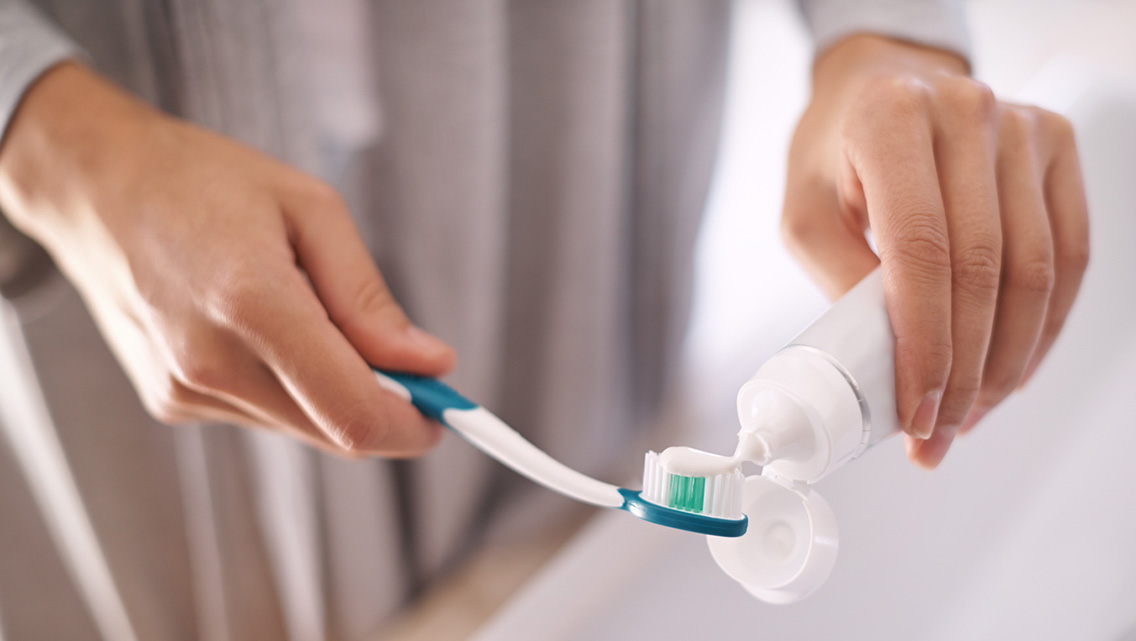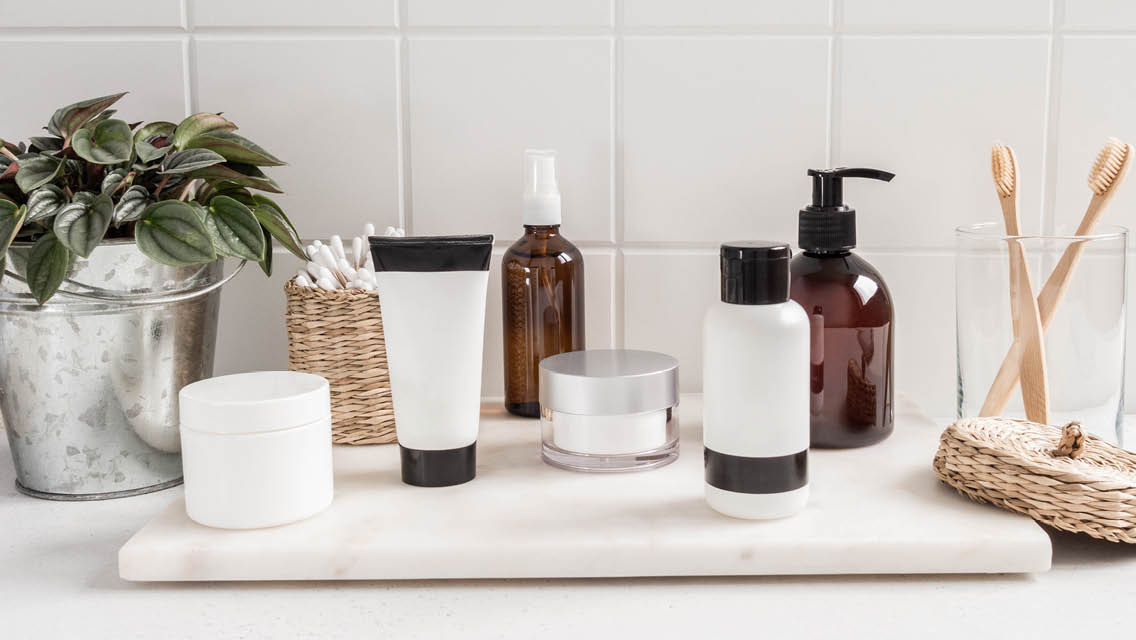Explore these common additives:
Titanium Dioxide (TiO2) | Triclosan | Sodium lauryl sulfate | Fluoride | Artificial coloring | Abrasive ingredients | Parabens | Propylene Glycol | Saccharin | Carrageenan | Aspartame | Diethanolamine
You’ve been rushing through the grocery store for an hour already. Your kids have thrown multiple unnecessary items into the cart. You’re famished, frazzled, and finally ready to check out.
Then you remember: You’re in dire need of toothpaste. That crumpled tube on the bathroom counter at home has been squeezed to its limit, and you’re confident that not even the tiniest speck of paste could be further extracted.
The problem is, once you arrive in the toothpaste aisle, you’re not exactly sure what to choose.
Whiter! Brighter! Fresher breath!
These empty promises and more scream at you from fancy packaging, and while you may be distracted by all that marketing jargon, it’s important to know that it’s what’s on the inside of those packages that actually counts. Turns out, there are a lot of superfluous — and dangerous — chemicals in toothpaste.
Many conventional toothpastes contain harmful ingredients can be difficult to recognize on the label. Below I’ve outlined which of those ingredients are harmful and why you should opt for nontoxic toothpaste.
Do a Toothpaste’s Ingredients Really Matter If I’m Not Swallowing It?
You may be wondering why avoiding toxic toothpaste ingredients is so important when toothpaste isn’t in your mouth for very long, and even when it is, you certainly don’t swallow it.
But here’s the deal: The mouth-body connection is very real, and bad oral health can contribute to heart disease, diabetes, osteoporosis, and other conditions. As a result, having a healthy mouth is paramount, and anything we put into our mouths — no matter how briefly — can affect our oral and overall health.
Our mouths are lined with protective mucous membranes, which can become irritated, inflamed, and infected with toxic ingredients. Our mouths can also absorb those chemicals into the bloodstream, while certain ingredients can disrupt the natural balance of flora (both “good” and “bad” bacteria) in our mouths that aids in maintaining our oral health. This imbalance can even affect your gut microbiome.
Here’s a closer look at some of the most concerning toothpaste additives:
1. Titanium Dioxide (TiO2)
What it is: Titanium dioxide is an inorganic chemical compound added as a colorant to make toothpaste white.
Why it’s harmful: While most studies have concluded that titanium dioxide is safe for topical use on skin since it isn’t absorbed, there haven’t been studies to determine if it is absorbed by the mucous membranes in the mouth. According to the Environmental Working Group, there is concern about inhalation of titanium dioxide, because it may be carcinogenic and could cause nonreproductive-organ-system toxicity.
It’s also important to note that titanium dioxide doesn’t provide any oral benefit; it’s simply part of a marketing tactic to appeal to those who like brilliantly white toothpaste.
2. Triclosan
What it is: Triclosan is a pesticide added to many consumer products as an antibacterial agent.
Why it’s harmful: There have been numerous animal studies that have linked triclosan to endocrine (hormone) disruption. It could also contribute to creating antibiotic-resistant strains of bacteria.
And consider this: The FDA has banned the use of triclosan in soap and body wash (but approves it for use in toothpaste). In my opinion, this is proof enough of the dangers of triclosan. Why would I put something in my mouth that I wouldn’t put on my hands?
3. Sodium lauryl sulfate (SLS)
What it is: SLS is a chemical compound used as a surfactant, detergent, and denaturant in various cosmetics and industrial cleaners. It’s also used as a foaming agent in toothpaste.
Why it’s harmful: Almost 16,000 studies have mentioned the toxic nature of SLS, yet it is still used in many cosmetic products, as well as most conventional toothpastes. EWG maintains that this chemical, which is also used as an insecticide, can cause irritation and organ toxicity. SLS irritates the mouth and strips away the lining, which can lead to canker sores.
Be careful when you’re looking for this dangerous, and sneaky, chemical in toothpaste ingredient lists. Manufacturers often list SLS by other names, including:
- Sodium dodecyl sulfate (SDS)
- Monododecyl ester
- Sodium salt
- Sulfuric acid
- Sodium salt sulfuric acid
- Monododecyl ester sodium salt sulfuric acid
- Sulfuric acid monododecyl ester sodium salt
- Aquarex methyl
- Akyposal SDS
- A13-00356
4. Fluoride
What it is: Fluoride is a chemical added to prevent cavities by aiding remineralizing of tooth structure.
Why it’s harmful: There’s a reason all fluoride-containing products come with an FDA warning: According to the Fluoride Action Network, even small amounts of fluoride can cause acute toxicity, characterized by nausea, vomiting, and headaches in its earliest stages. But the most shocking news about fluoride is probably the fact that no over-the-counter toothpaste formula contains enough of the substance to actually remineralize teeth, and manufacturers can’t add more because of FDA regulation.
Too much fluoride can also harm developing teeth in young children, who tend to swallow a lot of the toothpaste they’re using, leading to fluorosis, among other issues. Also, in order for topical applications of fluoride to be effective, it needs to be put on the teeth after brushing so that the biofilm is removed and fluoride can be absorbed. (FYI: I do recommend fluoride in certain circumstances but not in over-the-counter toothpastes, as the risk-reward ratio just doesn’t make sense.)
5. Artificial coloring
What it is: Artificial toothpaste colors are used to make commercial toothpaste aesthetically pleasing.
Why it’s harmful: Studies have linked artificial coloring chemicals to hyperactivity and ADHD in children; in fact, a study published in 2012 by Neurotherapeutics found that artificial food colors can have a negative effect on children even if they haven’t been diagnosed with ADHD. I don’t know about you, but I’m much more worried about how effective my toothpaste is, not how sparkly and blue it is.
6. Abrasive ingredients
What they are: Abrasive ingredients are added to toothpaste to help “scrub” biofilm from the teeth.
Why it’s harmful: Toothpaste only needs to be mildly abrasive to be effective. Some of the abrasives used, such as hydrated silica, are too rough. These ingredients can strip away the enamel and dentin, creating sensitivity and leading to gum recession.
7. Parabens
What they are: Parabens are chemicals used as preservatives to extend the shelf life of the toothpaste.
Why it’s harmful: The FDA is still reviewing and evaluating published studies on the safety of parabens. Known to disrupt hormones, parabens are used in most cosmetic products and even in most grocery items. Even if the levels in these individual products are considered “safe,” the accumulation in our bodies could cause problems, including a possible increase in the risk of breast cancer.
(For more about parabens, see “How Do Parabens in Personal-Care Products Affect My Health?“.)
8. Propylene Glycol
What it is: Propylene glycol is a synthetic chemical compound used as a surfactant.
Why it’s harmful: Although the FDA classifies propylene glycol as GRAS (generally recognized as safe), this compound is known to irritate the skin, eyes, lungs, and mucous membranes. Case in point: the industrial-grade form is used in antifreeze, detergent solvents, and paint. Based on research showing that propylene glycol was toxic in rats after long-term use, authors of a 2013 study advised that intake of propylene glycol (and artificial colors, incidentally) be limited, especially in children.
9. Saccharin (Sodium Saccharin)
What it is: Saccharin is an artificial sweetener used as a flavoring agent.
Why it’s harmful: Saccharin is a known carcinogen in rats, and although it hasn’t been shown to cause the same type of cancer in humans, I’m not comfortable with it being added to my toothpaste for the sole purpose of making it more palatable. Also, it can cause coughing, nausea, vomiting, and diarrhea.
10. Carrageenan
What it is: Carrageenan in toothpaste should be avoided. Carrageenan is a food additive extracted from red seaweed (also called Irish moss) and used as a thickener.
Why it’s harmful: Carrageenan has created intestinal issues, including inflammation and colon ulcerations, in some animal studies. Many people have reported intestinal distress that is resolved with the avoidance of carrageenan products. Additionally, the degraded form is a known carcinogen. During processing, the undegraded (food grade) form may be easily contaminated by the degraded form.
11. Aspartame
What it is: Aspartame is an artificial sweetener used as a flavoring agent.
Why it’s harmful: When aspartame is ingested, one of the chemicals in the compound is broken down into methanol, an alcohol. Our bodies cannot properly digest it in this form. It can travel through the blood and may be converted into formaldehyde. As this builds up in the body, the damage caused can include headaches, dizziness, weakness, memory loss, and gastrointestinal distress. A 2014 study also determined that aspartame is a possible carcinogen.
12. Diethanolamine (DEA)
What it is: DEA is a chemical used as a foaming agent in toothpastes.
Why it’s harmful: This compound is yet another known hormone disruptor, and the EWG ranks it at a full 10 on its hazard scale. It’s also used in some products to adjust the pH levels and can react with certain substances to create carcinogens. If that weren’t enough, DEA is also known to cause organ-system toxicity.
Making Your Own Toothpaste
Unfortunately, avoiding these harsh chemicals can be difficult. Again, I recommend downloading this list of the most harmful toothpaste ingredients, but if you want to be extra careful, I recommend taking a DIY approach. Making your own toothpaste isn’t foolproof, however, as I’ve seen DIY recipes that are just as harsh as mainstream toothpaste.
Start with my Complete Guide to DIY Toothpaste to learn more about which ingredients are great to use, and which ones should be left out when you’re mixing up your own blend. (And if you’re curious, here’s the exact recipe I use to make my own toothpaste at home.)
This article has been updated. It was originally published March 20, 2018.




This Post Has 3 Comments
Is there any toothpaste free of these ingredients that you would highly recommend?
What toothpaste options are available without the toxic ingredients mentioned in this article?
Excellent lesson. Thank you so much. At 85 years of life, I’m shocked that I’m just now learning all of this.
I’m going to print this article now and send this list just as you have presented it.
I will follow your future publications and take them very Seriously. So grateful.